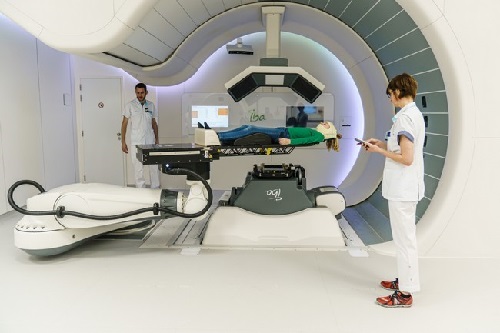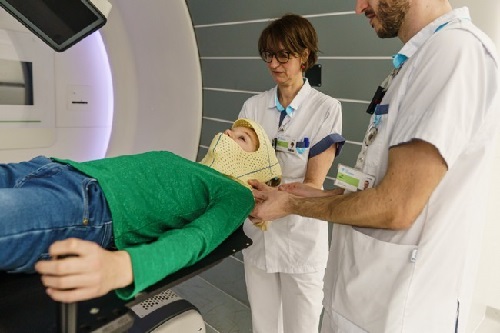The start-up of the ParTICLe proton centre - PDF Version
The Particle Therapy Interuniversity Center Leuven, in short ParTICLe, is the first proton centre to be set up in Belgium. Universitair Ziekenhuis (UZ) Leuven / Katholieke Universiteit (KU) Leuven and Cliniques universitaires Saint-Luc / UCL have developed one joint inter-university treatment and research centre for proton therapy that is partly supported by the university radiotherapy departments of Ghent, Antwerp, Brussels and Namur. This is a unique concept throughout the world.
Together with four nurses and one medical imaging technologist, I had the opportunity to participate in the start-up.
The Federal Agency for Nuclear Control stated in advance that the radiotherapists (RTTs) must have at least two years of experience in a radiotherapy service before they could start training with protons. That was no problem, since all six of us work at the radiotherapy department of UZ Leuven. The department is equipped with five linear accelerators (two TrueBeams, one TrueBeam STx and two Halcyons) and an integrated brachytherapy unit. Knowledge of radiotherapy was therefore already partly present in the team. This knowledge served as the basis for the proton project. To further strengthen the foundation, we first deepened our knowledge of radiotherapy. We were all trained in simulation, planning, image-guided radiotherapy (IGRT) and had undertaken a French course in order to be able to speak to patients from the French-speaking referral centres.
We also specialised in proton therapy. We received applied lessons on radiobiology, proton physics and radio protection. Gradually our jargon expanded to include technical terms such as the Bragg peak, pencil-beam scanning, multi-field optimisation (MFO), robustness ... and we increased our knowledge of the tumours that were eligible for proton therapy. We participated in proton network meetings at which the staff of several European proton centres came together to share their experiences. Afterwards, the contacts that we made there also gave us the opportunity to take a look at a Dutch centre. Firms presented masks, headrests and other specific proton-therapy accessories. Together with physicists and doctors, we looked at the pros and cons and decided which materials we would use. Our practical experience was of great importance in this decision-making. Sometimes something seems perfect in theory, but is unrealistic in practice. When patients lie on the treatment table for an average of 30 to 60 minutes, their stability is important, but comfort is also an important factor that must be taken into account. We practised the use of the immobilisation material on phantoms, on each other, and on each other's children. After all, children will be strongly represented in the proton therapy department. We immediately received feedback on the test patients’ experiences and immediately knew which were the points of attention that we should take into account in the future.
No treatment is possible without a device. The protons themselves are generated in a cyclotron and are conducted through the beam line until they leave from the gantry through the snout. The gantry itself looks elegant, and it is in fact a very impressive piece. To rotate the gantry, 90 tonnes must be set in motion. Proton therapy is precision work, so the device is equipped with various imaging modalities for daily imaging. We can use an on-board flat panel kilovolt (kV) source that enables us to take both a cone beam computed tomography (CBCT) and orthogonal images. Oblique imaging is also available, with two kV sources built into the floor and ceiling detectors. We also have an in-room computed tomography (CT) scanner that is available to treat adaptively if necessary. The device is completely new to us, but because we have time to practice, it feels a bit more familiar every day. Initial education by Ion Beam Application (IBA) took place for two RTTs at the proton centre who were linked to the University of Pennsylvania in the US. The others were given access to the online training material. We work with the principle “teach the teacher”. Later, all six of us received training in our own proton centre. The intention is that three RTTs will work on the device. We start with a permanent team of six, but this will be expanded in the future so that there can be more flexibility in the division of labour. Now we are almost exclusively involved in proton therapy. By training more RTTs, proton therapy will be integrated into the radiotherapy department and there will be more staff rotation.
The duration of a proton-therapy session will be approximately 45 minutes for an adult patient. More time will be provided for a paediatric patient because children are often treated under general anaesthesia. If the proton device should be defective, it is possible to divert to the photon department, which connects to the proton department. A photon back-up plan will be available for each patient.
As RTTs, we are also involved in the development and writing of procedures and protocols. Each scenario must be considered in advance. Working proactively is a must. Because proton therapy is a multidisciplinary matter, we work in a team of doctors, physicists, nurses and technologists. Everyone has their view of the situation and that view is determined by education, experience or background. In this way everyone looks at the same problem with a different set of eyes. Each has their point of view and all have the same goal: the best treatment for the patient.
.jpg.aspx)
Jolien Claes
Technologist medical imaging RTT
Department RO
UZ Leuven, Belgium
Inside the ParTICLe proton centre
.jpg.aspx)


